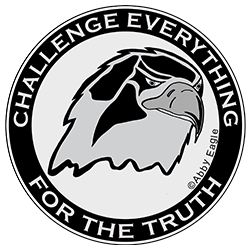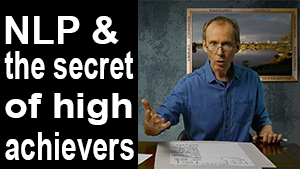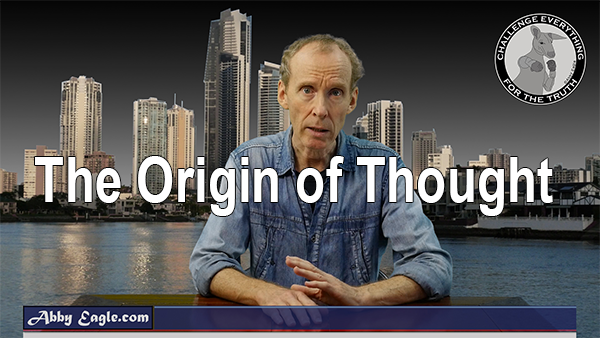
Abby Eagle discovered that all thoughts arise out of the unconscious mind - that it is impossible to have a conscious thought. In fact, it is difficult to make a clear distinction between conscious and unconscious mind.
What is important to understand is that you are a pure witnessing consciousness. The consciousness is aware of the thoughts. Simply put, thoughts are formulated in the right brain and shift across to the language centre in the left brain - which is a rough analogy for the unconscious and conscious minds. The act of writing these words is not a conscious process - I can be conscious of the process but I do not consciously write these words. Processes in the brain work together and the words come to mind. Anyway try the experiment that I give further down in this article and you will see what I mean. Phone 07 5562 5718 or send Abby an email to book a free 20 minute telephone or Skype session. Neuro Linguistic Programming (NLP) - online sessions available.
Click the Image to Watch on YouTube
What is the Origin of Your Thoughts? Try This Experiment.
By Abby Eagle (2018)
Excerpted from the book, God: The Greatest Misunderstanding in the History of Mankind. Page 23-25.
In this article I would like to share a discovery with you that I made some years ago about the origin of thought – and I am also going to give you the opportunity to try a very interesting experiment.
But first let’s take a quick look at some different styles of thinking. Here I am not referring to a preference for visual, auditory or kinaesthetic representational systems. I am not referring to personality types such as the Myers Briggs but to something else. Let me try and explicate it.
Some people will say, “I thought of something - I had an idea.” This type of people own their thoughts or you could say they are identified with their thoughts. When they have a profound thought they take ownership of the thought. They might say I had an epiphany.
Other people will say something like, “It was shown to me – it was revealed to me”. To this type of person some of their thoughts originate from outside of themselves. So this type of person has some way to differentiate their everyday thoughts from the special thoughts. We could say there is a submodality or meta program distinction. Even though everyone has revelations this type may put their revelation into a spiritual frame.
Some people may have thoughts, either visual, auditory or kinaesthetic which are so intense they take on the characteristics of a vision or hallucination.
Throughout the history of mankind some people have attempted to provoke spiritual experiences through extended periods of fasting, prayer, meditation, dancing; or sensory deprivation such as climbing to the top of a mountain and sitting in a dark cave, or going alone into a wilderness. In every case they set a frame of mind that is conducive to provoking thoughts that are different to their everyday thoughts.
So keep in mind that he who sets the frame controls the game. The highest frame defines everything below it. So let us set some more frames for this discussion.
You have a conscious and an unconscious mind.
You communicate with yourself and others through the use of questions, statements and commands. And in the context of this discussion ‘others’ could be a real person - or it could be your unconscious mind, god, an angel or some historical person.
Another frame to keep in mind is that you have a personality type. A passion and interests. And a purpose – that is a value system which provides the why you do what you do.
You have a history – a present situation and a desired outcome.
You then set an intention which drives your attention onto the task at hand so that you can focus in and concentrate. Such that time may disappear and you are plunged into the eternal now. And such that the critical voice disappears and you have a positive coaching internal dialogue. This is a state of flow sometimes known as the zone. Everyday you should aim to get into a flow state and I have talked about this in my previous videos. Steven Kotler has some excellent videos on the topic. Now action sports athletes enter profound flow states yet we hear very little about their experiences – yet on the other hand when some would be mystic gets into the flow in a mountain cave he can’t wait to run back to town and tell everyone about his experience.
Okay so going back to the beginning of this discussion one type of person will say I thought of something, I had an idea. While the other type will say it was shown to me it was revealed to me. One is more rational while the other is not so rational. It could be that one is making a decision based upon facts and logic while the other is making a decision based upon feelings. There is also something about ownership and responsibility for the thoughts.
Now get ready to pause the video so that you can do this experiment on the origin of thought.
If you pay close attention to your thinking process you will find that when you think of something, the unconscious mind acts before the conscious mind does. When you think of something the visual image precedes the auditory statement. For example, think to yourself that you will think up a list of things, say a list of animals.
Then say to yourself, either out loud or in your mind, “See a dog.” But before you say ‘dog’ the image of a dog will have appeared in your mind. The visual image precedes the word. Try it again with other things and before you can say the name of the thing it will have appeared in the mind. So even though you may think that the process is a conscious activity it is largely unconscious.
Levels of mind are utilitarian. In fact it is quite difficult to make a clear distinction between conscious mind and unconscious mind. Some people would say that memories that you can access consciously are in the realm of the conscious mind while memories, such as those before the age of 4 are in the realm of the unconscious mind but when you look at the actual process involved of accessing a memory, whether that be from yesterday or before the age of 4, or even of a past life memory, it is done so by asking questions of the unconscious mind.
For example, “What did you have for breakfast yesterday?” Eliciting information before 4 years of age and from past life memories can be done in much the same way – without using hypnosis. The only difference is that it requires much more precision, focus, concentration and awareness.
In a way you could say that there is no conscious mind – what we have is a conscious process driven by the consciousness. Either way, all thoughts arise out of the unconscious mind onto the screen of consciousness. Consciousness is a silent witness to the thinking process. You can be aware of the thought processes or not.
For example, a cigarette smoker may claim that the smoking just happens – it is an addiction, yet with some probing we find that a thought process precedes the action of picking up the cigarette. There is the thought, “I feel like a cigarette.” But until their attention is brought to it, it is not something they are conscious of.
The NLP Hypnotherapist helps the smoker develop awareness of the thoughts that arise in the mind and then gives them tools to work with the unconscious mind so that the thought for a cigarette no longer arises in the future.
Getting back to our list of animals. If you step back a bit you would probably find that the act of thinking of the list of animals in the first place also fits the same pattern. Perhaps all conscious thought is interpolated with the unconscious mind presenting its contribution in the form of either a picture, sound, feeling, smell or taste?
Perhaps the sense of ‘I’ (ego) likes to think that it is in control of the thought process? In fact all thoughts are processed at the level of the unconscious mind and then shift across to the language centre in the left hemisphere of the brain, to be acted upon by the so called conscious mind or sense of self associated with the language centre.
Maybe as, or when, the ‘I’ dissolves you will discover there is no one doing the thinking. Maybe it is just the ‘I’ being the centre of the mind that creates the illusion that there is someone doing the thinking? And that it is just the expectation of the ‘I’ that the image of the dog should not appear until after it had thought of the dog ‘consciously’.
So this begs the following two questions: “Who is the one who made the decision in the first place to think of the list of animals?” And, “Who is the one who is aware of having asked the question and observed the image preceding the statement?”
Try this. Make a slow sequence of thoughts, one word at a time. If you identify with the thinking then you ‘think’ that you are doing the thinking. However, when you bring yourself back to meta position you find there is no one doing the thinking. But if no one is doing the thinking then who is directing the process because there obviously has to be some awareness, some intelligence, some consciousness that is directing the thought process. It is not just random thinking and action, or is it?
In your mind very slowly form a sentence, word by word. You will find that the words appear slightly after ‘something’ – that is an intention to form the sentence, to think of something, to do the experiment. So backing up from the image of the dog that formed after the words, you would find that the words appear after an ‘intention’ to form a sentence.
The mind – the ‘I’ quickly grabs hold of the visual image of the word and says the internal dialogue. It repeats the word which was formed as an image. The ‘I’ is trying to own the words that it saw appear on the screen of consciousness. So once again who is the silent witness to the whole process?
You will find that as you practise the aforementioned experiment that when you bring your awareness to the internal dialogue, that is to the spoken words not the original image of the words, that the internal dialogue disappears.
The conscious process of thinking – the internal dialogue with images, etc, has already occurred at the level of the unconscious mind. You can sense this sometimes when you are very alert. The unconscious process is like a soft dream like process – the conscious process is just a replication, with perhaps some embellishment. The conscious mind is like the person who having heard something on the news repeats it to their friends. When some people experience their unconscious process as being separate to them they call it ‘channelling’.
So which type of person are you? Are you the type who says I thought of something – I had an idea. Or are you the type who says it was shown to me – it was revealed to me?
If you liked this article please consider buying my book, God: The Greatest Misunderstanding in the History of Mankind. It is available on Amazon as a paperback and on my website as a ebook. And please leave a comment below so that we can get a discussion happening.
Share With Friends
| DISCUSSION GROUPS | |
|---|---|
 |
|
| NLP Future Selfing | |
| NLP, Hypnotherapy & Meditation | |
| NLP Peace Mapping | |
| Facebook Discussion Group | |
| The secret of high achievers |
|---|
 |
| How to build a powerful team |
 |
| Learn the NLP Meta Model |
 |
| How I stopped drinking alcohol. |
 |
| How to coach yourself using NLP. |
 |




